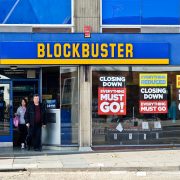Last weekend, I noticed more than a few friends posting to their Facebook pages about going to pay one final visit to Toys R Us. Like many brick and mortar retailers, the famous toy store has found itself drowning in a market now dominated by online retailers. This news has pulled at the heartstrings of many, who have fond memories of the toy store, as my newsfeed can attest.
It’s understandable to see why so many adults are getting sentimental about this closure. As children, Toys R Us was almost as exciting as Disneyland. The store had everything you could ever dream of wanting to play with as a child. Even if nothing was being purchased, just strolling down each aisle was a true pleasure.
But just because Toys R Us is leaving doesn’t mean we have cause to mourn. In fact, the death of the toy store symbolizes the beginning of a new era where tech and online shopping have made the store irrelevant. And this creative destruction is all part of the of the market process.
Creative Destruction
For the average person, a massive store like Toys R Us closing can stir up a lot of emotions. In addition to the sentiment, a big company closing means that many people will now be out of a job. Not to mention, this only adds to the hysteria surrounding the closure of many other brick and mortar establishments. In fact, Trump has, on many occasions, proposed taxing online retailers like Amazon because of the impact they are having on other physical businesses.
But the world is not stagnant. The market always changes. And with those changes comes the opportunity for new innovation. And where old jobs are done away with, new jobs are always created.
When the news of Toys R Us closing was first released, many headlines told stories of national concern over what was to happen to the 33,000 people who would soon be out of a job. And while job loss is never something that should be celebrated, there is another angle here that is not being discussed: creative destruction.
The term creative destruction was coined by economist Joseph Schumpeter and is described by Investopedia as:
“The process of industrial mutation that incessantly revolutionizes the economic structure from within, incessantly destroying the old one, incessantly creating a new one. This occurs when innovation deconstructs long-standing arrangements and frees resources to be deployed elsewhere.”
And that is exactly what is happening with Toys R Us. As economist Antony Davies commented:
“Think about the young parents who are buying toys for the kids. Where are they buying them? They are buying them from eBay, from Amazon, so at the same time we are losing jobs at Toys R Us we are gaining jobs there….It is something economists call creative destruction. That is, we lose some jobs in one place, but we gain others somewhere else.”
Commenting on creative destruction further, Schumpeter once wrote:
“The function of entrepreneurs is to reform or revolutionize the pattern of production by exploiting an invention or, more generally, an untried technological possibility for producing a new commodity or producing an old one in a new way, by opening up a new source of supply of materials or a new outlet for products, by reorganizing an industry and so on.”
This makes perfect sense when we look at the current market for toy consumers. As Davies says:
“In the great scheme of things, this isn’t surprising because what we have is the first generation that has grown up with the internet. They’re old enough, they’re starting to have babies, and they’re looking for toys and what do they do naturally? They go to the internet.”
Additionally, it is so much easier to buy toys online than it is to load the kids in the car and haul them across town to the local toy store. Amazon and other online retailers have made it more convenient than ever to shop for toys. And while kids today might not have the same memories of strolling through the aisles of Toys R Us as their parents did, they will be making their own new memories.
Each time an older, perhaps outdated, business bites the dust, there is ample opportunity for a new, better idea to take its place. And with new innovation comes the need for new jobs.
Toys R Us isn’t likely to be the last brick and mortar casualty of the virtual revolution. But we needn’t be discouraged by these changes. The market will always evolve and change to meet the needs of consumers. And while jobs might be temporarily lost, new jobs will always be created as part of the market process.













